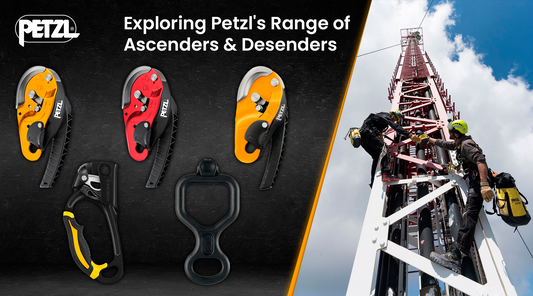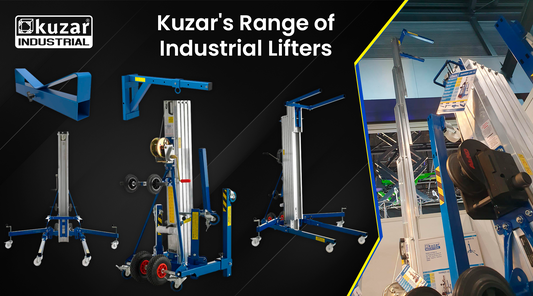When To Replace Your Shackles (+Shackle Inspection Checklist)
Shackles are essential components in lifting and rigging operations, and, as a result, proper inspection is crucial to ensure their safety, functionality and to prevent load breakage.
In this blog post we will discuss:
- Shackle Inspection Checklist
- Shackles available at MTN SHOP
- Hazards Associated with Using Broken Shackles
Shackle Inspection Checklist
To ensure that the shackles you are using are in good condition and fit for purpose, you should carry out a visual inspection prior to each use. A visual inspection of your shackles can be conducted following the below steps:
1. Check For General Wear & Tear
If your shackle has more than a 10% difference in the dimensions that it is stated to have (you should find this in the user manual or product page), it should be discarded. It will not be able to handle the rated load as the physical size of the shackle has become smaller since its purchase.
A shackle that has exceeded its lifespan may look something like this:

2. Check For Corrosion & Dents
If you find your shackle to have dents on the surface or the metal has corroded, you should cease use immediately as the physical size of the shackle has been reduced - meaning it would be unsafe for it to be carrying heavier loads.
A corroded shackle will look similar to this:

3. Check For Signs Of Heat Damage
When producing shackles, they undergo a heat treatment procedure. Consequently, exposure to heat in the field has the potential to reverse this treatment, leading to a weakening of the shackle. This can look like a blue discoloration on the shackle.
4. Inspect That Load Bearing Components Are Not Distorted
Any shackles that are distorted from their original shape should be immediately removed from service. This can include shackles that may have become bent, twisted, distorted, elongated, cracked or broken.
Below is an image of a distorted shackle that has lost its shape:

5. Check For Manufacturer Details
Check for markings that state the manufacturer and the shackle's working load limit (WLL). If these have rubbed off, this may be an indication you need to replace your shackle.
For example, the CM logo is shown clearly on their Screw Pin Shackle
6. Check For Any Faults To The Load Pins
When load pins become bent, it indicates that the pin has surpassed its elastic limit, which is the maximum stress the shackle can withstand when carrying a load. If the equipment is still utilized under such conditions, the risk of a dropped load significantly increases, posing potential harm to operators and causing damage to property. Thread damage implies that the pin fails to achieve 100% engagement with the shackle. This increases the risk of shackle failure which can lead to load damage.
Below is a shackle equipped with the incorrect pin for its model:

Explore our range of Shackles at MTN SHOP
Here at MTN SHOP, we supply an extensive range of Shackles from industry leading brands such as CM, Crosby and Kuzar. Take a look at some of our top picks:
CM Super Strong Anchor Shackles (Screw Pin)
CM’s shackles are world renowned for their strength and design. CM’s Super Strong Anchor Shackles are carbon-type shackles with strength ratings that are 17 – 50% stronger than comparable-sized carbon shackles. These shackles are designed with a 6:1 design factor and can be side-loaded or used for multiple connections. This style has a screw pin and is available with a galvanized or orange powder coated finish.
CM Super Strong Anchor Shackle (Screw Pin)
Kuzar Shackle
You can ensure quality when you shop Kuzar! The SH4 Shackle from Kuzar features an 800kg load limit, perfect for heavier duty lifting applications.
Crosby Galvanized Bolt Type Chain Shackles
Crosby's Galvanized Bolt Type Chain Shackles are ideal for heavy-duty lifting applications, with working load limits ranging from 2 to 85 metric tons. They are forged from high-quality steel and quenched and tempered to ensure exceptional strength and durability. The alloy bolts provide added strength and resistance to corrosion and the shackles are also hot dip galvanized for enhanced protection against rust and corrosion. These shackles are fatigue rated for applications that involve dynamic loads, and those weighing 25 tons or more are equipped with RFID tags for easy identification and tracking. They are approved for use in extreme temperatures, from -40 degrees Celsius (-40 degrees Fahrenheit) to 204 degrees Celsius (400 degrees Fahrenheit). The 3.25-ton to 25-ton shackles meet the charpy impact testing requirements of 42 joules at -20 degrees Celsius (-4 degrees Fahrenheit), making them suitable for cold-weather operations. These shackles comply with all applicable industry standards, including ASME B30.26.

Crosby Galvanized Bolt Type Chain Shackles
Hazards Associated with Using Broken Shackles
Here are some of the common risks and hazards associated with the use of broken shackles:
Personal Injuries:
Failing Loads: Broken shackles can cause a load to fall unexpectedly, resulting in serious injuries to workers in the immediate vicinity.
Flail Injuries: Broken shackles can cause loads to become dislodged from their place and swing violently,
Strains and Sprains: Lifting or moving heavy loads incorrectly to compensate for a broken shackle can lead to strains, sprains, and other musculoskeletal injuries.
Property Damage:
Damaged Equipment: Broken shackles can damage the load being lifted, causing dents, scratches, or cracks. In extreme cases, broken shackles can cause the load to disintegrate, resulting in widespread damage.
Damaged Premises: Falling loads can damage buildings, structures, vehicles, and other property in the vicinity.
Production Delays: Accidents involving broken shackles can lead to production delays, downtime, and increased costs for repairs or replacements.
Shackles can take on immense loads and ensure smooth operations. However, like any hardworking tool, they require proper care and attention to guarantee safety and reliability. Regular inspections are crucial to catch any signs of wear, damage, or fatigue before they lead to a potential accident. Remember, a quick inspection today can prevent a major issue tomorrow.





